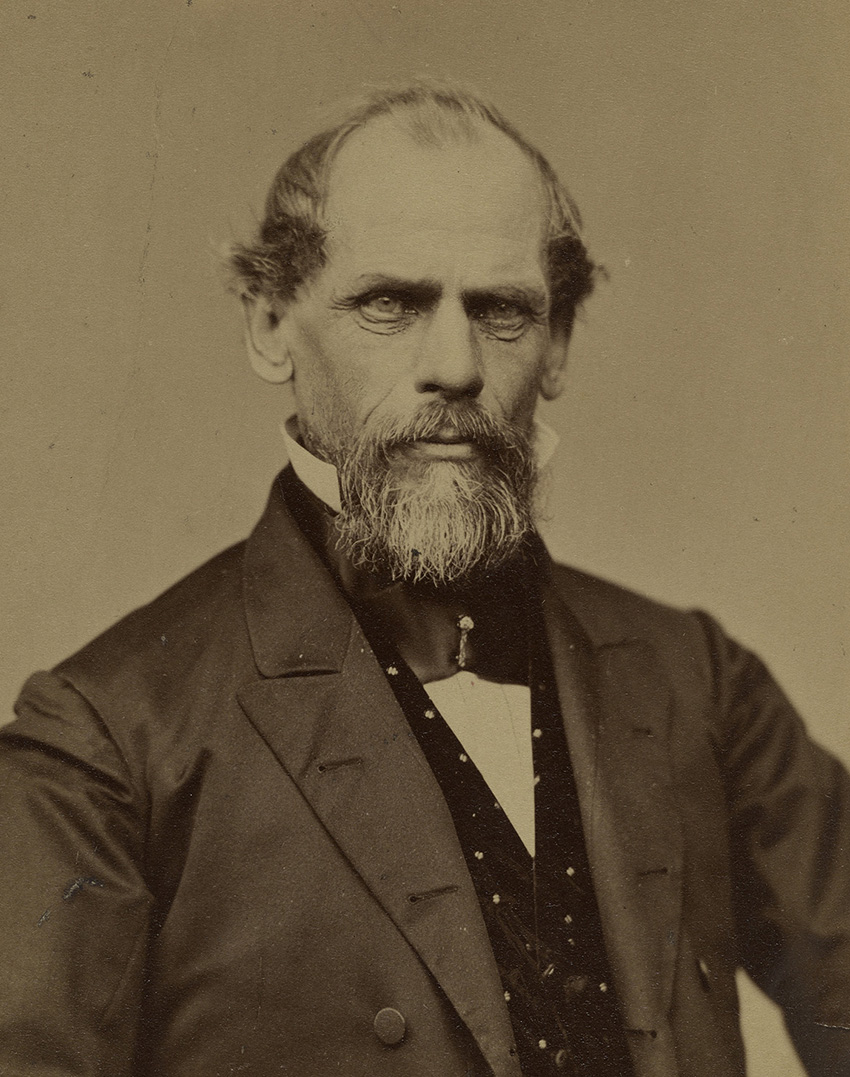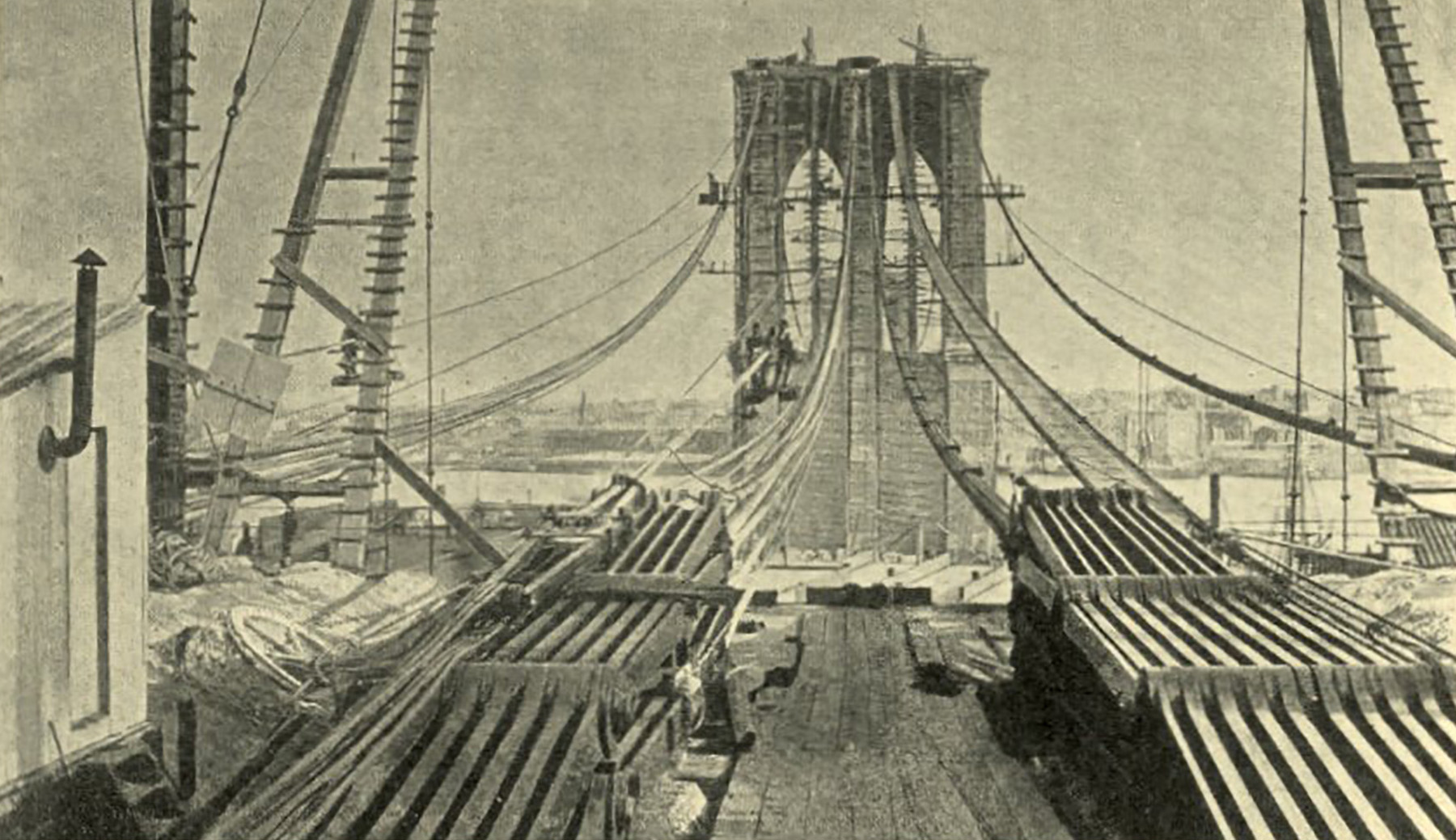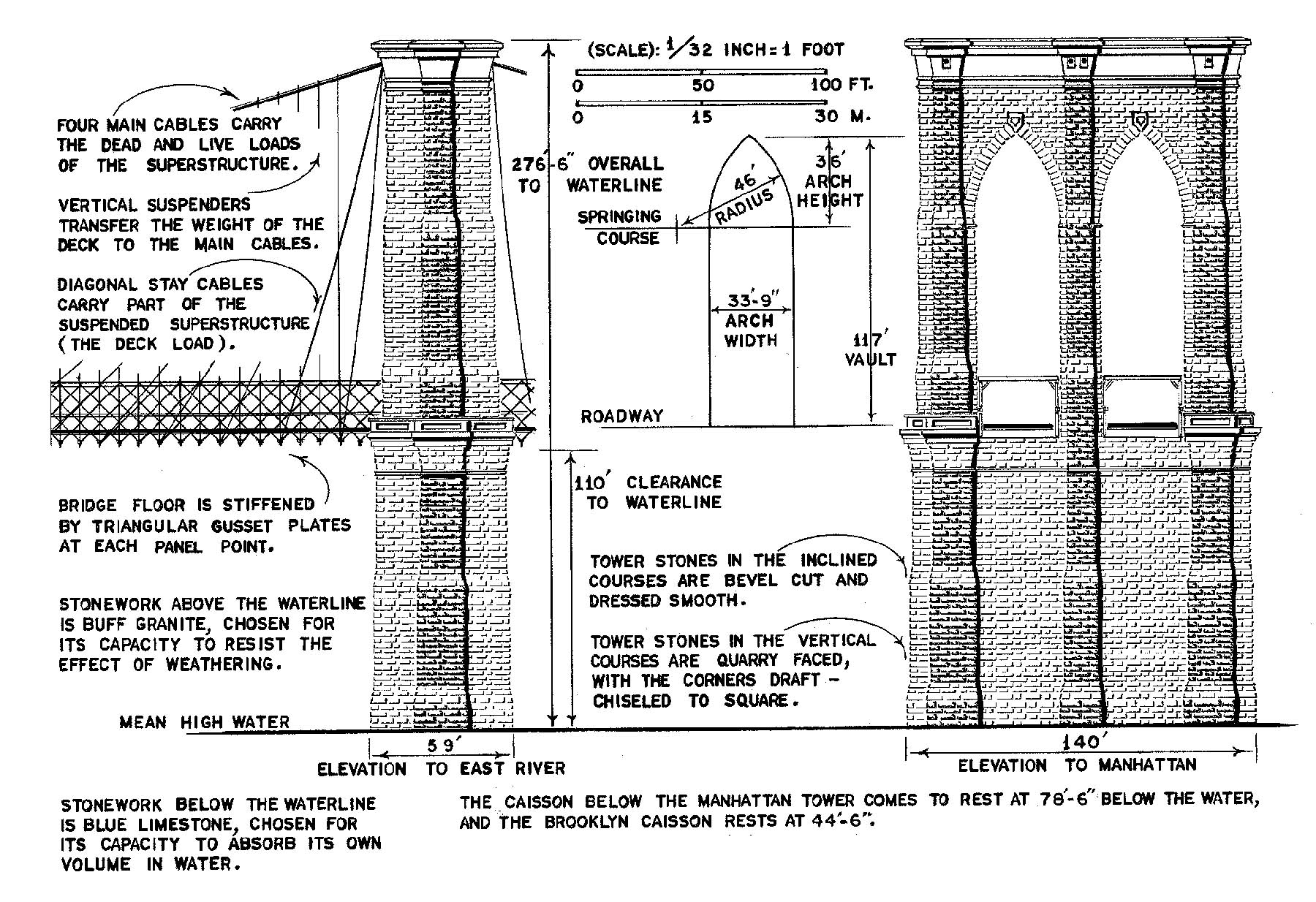
By T.R. Witcher
Among American bridges, one could argue that there are only two historically significant, technically astounding, and surpassingly beautiful masterpieces. The 1937 art deco Golden Gate Bridge in San Francisco, which crosses the strait between San Francisco Bay and the Pacific Ocean, is one.
The other has gone by many names — the Great Bridge, Roebling Bridge, Empire Bridge — but since it opened in 1883, we’ve come to know it simply as the Brooklyn Bridge. Though bigger, more impressive bridges have long since joined the island of Manhattan with New Jersey and the outer boroughs, none contain the stony grandeur of the first.
The story of the Brooklyn Bridge, which was named a National Historic Civil Engineering Landmark in 1972, is one of engineering innovation, with its use of large pneumatic caissons and steel-wire suspension cables. But the bridge is also a symbol of an era of rapid progress and industrialization, a sign of a nation — and its largest cities — gathering self-confidence and swagger.
According to an unnamed observer of the era, who is quoted in historian David McCullough’s comprehensive history of the bridge, The Great Bridge: The Epic Story of the Building of the Brooklyn Bridge (New York City: Simon and Schuster, 1972), a structure crossing the crowded East River would require, “one grand flying leap from shore to shore over the masts of the ships. There can be no piers or drawbridge. There must be only one great arch all the way across. Surely this must be a wonderful bridge.”
That the bridge turned out as well as it did was a consequence of three individuals who all bore the same last name.

The first, John A. Roebling, was a celebrated German-born engineer who studied architecture, hydraulics, and bridge construction at the Bauakademie in Berlin as well as philosophy under Georg Wilhelm Friedrich Hegel. Roebling immigrated to the U.S. in 1831 to make his name and fortune. In 1832, he co-founded the town of Saxonburg, Pennsylvania, which is north of Pittsburgh, and he began his civil engineering career in the U.S. building dams and locks and surveying routes across the Allegheny Mountains. It was in this rugged region that Roebling developed the innovation that would revolutionize bridge building.
The 36 mi Allegheny Portage Railroad had opened in 1834 in Johnstown, Pennsylvania, about 70 mi east of Pittsburgh. The railroad hauled boats up more than 1,400 ft through the Alleghenies, along 10 steam-powered inclines, bridging the divide between the Susquehanna and Ohio rivers.
To haul boats and barges up the inclines, the railways used giant, mile-long hawsers made from Kentucky hemp, according to writer Erica Wagner’s history of Roebling’s son, Washington, in Chief Engineer: Washington Roebling, the Man Who Built the Brooklyn Bridge (New York City: Bloomsbury Publishing, 2017). These big ropes, she wrote, “could cost three thousand dollars apiece, a fortune at the time — and they were prone to fraying and breaking; inevitably the resulting damage to loads and goods — and life — was costly and dangerous, too.”
Roebling had a better idea: Instead of hemp, he proposed ropes made of inch-thick iron wires, which would be, according to McCullough, stronger and more durable. By 1841, Roebling began testing wire ropes on the railroad, and by 1842, Wagner wrote, he had hit on a viable solution: seven strands “arranged into a rope with a central core of wire supporting the outer strands. The strands, each composed of nineteen individual wires, were parallel to each other, rather than twisted like ordinary rope.”
Roebling patented his invention in 1842, wire cabling became the standard for suspension bridge construction, and he eventually became a millionaire (the Golden Gate Bridge used Roebling steel-wire cables).
In 1849, at the age of 43, Roebling relocated his company, the John A. Roebling’s Sons Co., and his family to Trenton, New Jersey. His wire suspension cables led to a prolific career as a bridge builder, including bridges in Pittsburgh and downstream from Niagara Falls, where it connected New York state and Ontario. In 1866, he built what was then the longest suspension bridge in the world, the Cincinnati-Covington Bridge (later renamed the John A. Roebling Suspension Bridge), connecting Ohio and Kentucky.
The post-Civil War cities of New York (the modern-day borough of Manhattan) and Brooklyn were booming. According to Wagner, a ferry had crossed the East River as early as 1642. By 1870, she wrote, “The New York Times estimated that seventy million crossings were made every year — over half of those on the fourteen boats belonging to the Union Ferry Company, then the wealthiest ferry company in the world.”
To allay the river’s congestion, state officials considered the possibility of a bridge. Proponents of the plan saw the potential for great prosperity for both cities if a modern bridge could be constructed to connect them. In 1867, the New York State Legislature passed a law chartering a private company, the New York Bridge Co., to construct the bridge. In 1868, after two ferries collided, injuring 20 and killing a small boy, public support for a bridge grew. A year later, according to Wagner, Congress authorized construction of the bridge but stipulated that it could not disrupt boat navigation on the East River.

The New York Bridge Co. hired Roebling as chief engineer. Roebling’s plan for the bridge — which would become the largest suspension bridge in the world — called for a central span of 1,595.5 ft and a total length of 5,989 ft. Its two towers, comprised of limestone below water (which could absorb its volume in water) and granite above water (which could resist weathering), would rise 268 ft in the air — taller than every building in New York at that time save the spire of Trinity Church in Lower Manhattan, according to McCullough. The road deck would sit 135 ft above the river at the center of the span, sufficient to not disrupt boat traffic.
In addition to the standard main cables and vertical suspenders, the bridge would use diagonal, inclined cable stays that would, McCullough wrote, “radiate down from the towers and secure at various points along the bridge floor, both in the direction of the land and toward the center of the river span.”
Finally, the bridge would feature train tracks and an elevated pedestrian promenade. Roebling’s dream, as McCullough described it, was to create a “grand harmony of opposite forces — the steel of the cables in tension, the granite of the towers in compression.”
But Roebling did not plan a utilitarian structure.
According to a 1985 Historic American Engineering Record/National Park Service schematic (HAER NY-18, sheet 1) on the bridge, delineated by Paul Berry (below), the Brooklyn Bridge resembled nothing so much as a Gothic cathedral, owing to: “the resemblance to leaded window tracery produced by the intersecting cables, the appearance of a tapering spire created by the inclines coursed of beveled stones, the impression of a double doorway given by the high lancet arches over the roadway, (and) the effect of a church facade made by the projecting front buttresses.”
And Roebling did not lack for confidence. “The completed work,” he bragged, according to McCullough, “when constructed in accordance with my designs, will not only be the greatest bridge in existence, but it will be the greatest engineering work of the continent, and of the age.

“Its most conspicuous features, the great towers, will serve as landmarks to the adjoining cities, and they will be entitled to be ranked as national monuments. As a great work of art, and as a successful specimen of advanced bridge engineering, this structure will forever testify to the energy, enterprise and wealth of that community which shall secure its erection.”
Still, not everyone was convinced, and other ideas were floated, including a tunnel (preferred by Scientific American magazine) and a dam with a highway. McCullough wrote that during a series of lectures hosted by the New York Polytechnic Society, engineers expressed their concerns that the bridge was a “wild experiment,” or as McCullough himself noted, “nothing but an exercise in vanity.”
In the end, Roebling convened a panel of engineering experts, including William Jarvis McAlpine, president of ASCE, to scrutinize his plans for the bridge. But Roebling’s work on the bridge came to an unexpected end on June 28, 1869, when his foot was crushed in a boating accident at the Fulton Ferry Slip. He contracted tetanus, a bacterial infection, which led to lockjaw — an inability to open his mouth to eat or drink — and suffered terrible seizures.
He died on July 22.
Suddenly, the most important bridge project in America had lost its chief engineer. But Roebling had a son, 32-year-old Washington Roebling, a Rensselaer Polytechnic Institute-trained engineer and decorated Civil War veteran. He was a man who may have lacked his father’s engineering genius, but he was eminently capable of completing the daunting work, having helped his father build the Cincinnati bridge. He and his wife, Emily Warren Roebling, had just returned from a two-year tour of Europe to study pneumatic foundations. And he knew the ins and outs of the suspension cables. “I was the only living man who had the practical experience to build those great cables,” he later boasted, according to McCullough.
The board of the New York Bridge Co. appointed him chief engineer on Aug. 3. The younger Roebling knew the stakes. “He would be forever compared to the old man and held accountable for things said or promised by him,” McCullough wrote. A successful project would be his father’s success. Failure would belong only to him.
The Brooklyn Bridge represented cutting-edge engineering in at least two respects. One was its use of pneumatic caissons. These hollow structures filled with compressed air, which allowed workers to safely excavate under water, were relatively new at the time. The great bridge builder James Eads had deployed them in 1869 to build the Eads Bridge across the Mississippi River in St. Louis, but the size of the Brooklyn and New York caissons was much larger. (See “A Pioneering Structure: The Eads Bridge,” Civil Engineering, November 2017, pages 42-45.)
According to the HAER report, the bridge’s two “caissons were open wooden boxes, iron bound, 102 feet wide and 172 feet long, set in the river — open side down. The water was driven out by compressed air, and the caisson was forced to the river bottom by successive stone courses of the tower laid directly on its roof.”
The New York-side caissons extended to a depth of 78.5 ft, while the Brooklyn caissons hit bedrock at 44.5 ft. The caisson work was dangerous and unpredictable. Wagner described an explosion that occurred when one of the caissons accidentally depressurized when water levels in one of its shafts dropped too low. Wagner recounted Roebling’s own description of the calamity: “The water, stone & mud were sent up with terrific force to a height of 500 ft, accompanied by a dense cloud of fog owing to the expansion. The whole neighborhood was covered with mud.”
Still, after repressurizing the caisson, an inspection revealed that the structure, which contained about 110,000 cubic ft of timber and more than 200 tons of iron, was still intact. Washington Roebling calculated, in Wagner’s account, that the caisson might have “borne as much as eighty tons of weight per square foot in the moment of impact.” Despite this, it had compressed by only a few inches; the finished bridge would have to accommodate only a fraction of that weight.
Of greater concern was the health of the workers. E.F. Farrington, Roebling’s master mechanic, likened the interior of the caissons to conditions described in Dante’s Inferno, with strange confusing noises and shadows set against the inexplicable acceleration and deceleration of workers’ normal pulse rates. It could be damp, dank, and putrid inside. And workers often became unexpectedly sick when they emerged from their shifts. Some 110 workers developed decompression sickness, or the bends, which medical doctors at the time were struggling to understand.
Roebling developed the bends and was wracked by pain off and on for years. In fact, for large stretches of the construction he was basically an invalid. It was the third Roebling — his wife, Emily — who was instrumental in keeping the bridge project moving forward. She served, McCullough wrote, as his “amanuensis” — keeping his records, answering his mail, and communicating on his behalf. “When bridge officials or representatives for various contractors were told it would be acceptable for them to call at the Roebling house in Brooklyn, it was seldom if ever the Chief Engineer who received them,” he wrote.
And Emily had a perfect command of the facts about the bridge’s engineering. Most visitors, McCullough added, “left quite satisfied that her husband would be correctly apprised of everything said. But so impressed were some that they went out the door convinced they had met with the Chief Engineer after all and their future correspondence would be addressed directly to her.”
Once the towers were completed by 1876, work began on the steel cables. The handful of suspension bridges that had been constructed up to that point used wire ropes made from iron. But the Brooklyn Bridge employed steel, which was much stronger in tension and eventually became the standard for bridges. Using iron, Roebling had written, according to Wagner, would “necessitate a cable of such weight and size that it would become unmanageable and involve the greatest difficulties in making it.”
According to the HAER report, the bridge’s four main cables “were each composed of 5,434 continuous steel wires.” The total diameter of the cables was 15 ¾ in., and the cables were attached to 60,000-ton masonry anchorages.
The bridge was completed in 1883 and on its first day, May 24, welcomed around 150,000 people and 1,800 vehicles. Within five years, more than 30 million passengers crossed the bridge by train each year.
The Roeblings moved to Troy, New York, to be close to their son, who was studying engineering at Rensselaer. Emily went on to receive a law degree and died in 1903. Washington never designed another bridge but despite his struggling health, lived until 1926.
The Brooklyn Bridge still defines Manhattan and Brooklyn. It is an optimistic American infrastructure style that is equal parts engineering bravura and architectural artistry. On an average day, according to the New York City Department of Transportation, the bridge carries more than 100,000 vehicles as well as 4,000 cyclists and 10,000 pedestrians on its world-renowned promenade.
The bridge has proved remarkably durable over its lifetime. It was remodeled in 1948 by engineer D.B. Steinman to provide more road capacity. In 2019, the NYC DOT embarked on a $337 million renovation of the bridge. This included strengthening the towers against seismic activity and “correct(ing) structural deficiencies in the masonry arches of the bridge’s approaches on both sides of the East River,” according to the NYC DOT.
Washington Roebling would probably not be surprised. When slippage of the bridge cables of less than an inch was detected in 1922, there were cries to rebuild the bridge. Wagner wrote that Roebling was dumbfounded: “‘Rebuild the bridge?’ There is no necessity to rebuild. It will last 100 to 200 years. Isn’t that long enough?”
T.R. Witcher is a contributing editor to Civil Engineering.
This article first appeared in the July/August 2022 issue of Civil Engineering as “Bridge of the Century.”



